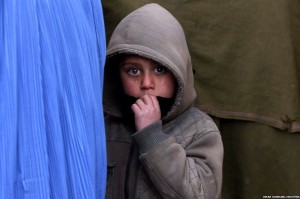Caricature this. Emancipation US-style: this little guy is lined up with his mother at a refugee camp in Kabul, Afghanistan to receive food from the World Food Program (WFP), a UN agency. Studies done by the World Bank & WFP show that nearly one-third of the 31 million Afghanis are “food-insecure.” In normal language that means they don’t have enough food to eat. A staggering 60% to 85% of children suffer chronic malnutrition. One study parsed things even finer & said about five million more people are “borderline food-insecure.” You have to admire the bureaucratic mind that can make a distinction between starving & borderline starving. How do you measure that? Does a spud a day tip the balance?
Afghanistan has an agricultural economy. It grows potatoes, wheat, cereals, several fruits & nuts, & of course, poppies for the opium market. But much of this is for export & all is governed by the market economy. The food prices are reportedly sky high & if you don’t have money, you don’t eat. That makes sense under capitalism.
The WFP is the very soul of diplomacy in explaining why so many Afghanis are starving. They talk about uncontrolled grazing, illegal logging, drought, environmental degradation. They say “insurgent activity & military operations have affected food security in some regions.” Maybe they could spell it out & admit that farmland for food staples is more profitably used for poppies & that war & drone bombing have proven incompatible with farming.
In 2009, WFP announced it would provide food for 8 million people. Two years later, it announced it would cut food aid to over 3 million Afghanis because of a shortage of money from donor nations. Just like in Haiti & Gaza, regimes pledge donations they never deliver. WFP said then it needed at least $220 million more to continue at previous levels.
In 2014, USAID claimed it provided over $30 million of “in-kind food assistance” to WFP operations to feed 3.6 million people through 2017. What in the hell is “in-kind food assistance”? Can you eat it? Is it a chit for the supermarket? USAID also boasted it was the largest contributor of food assistance to WFP in 2014 but it’s a drop in the bucket compared to the money it usually spends bribing Afghani officials.
It should be said that a country that occupies another, destroys its agriculture, creates millions of homeless & refugees, & makes life a living hell for millions has a hell of a lot of nerve treating humanitarian aid like noblesse oblige.
(Photo by Omar Sobhani/Reuters)
